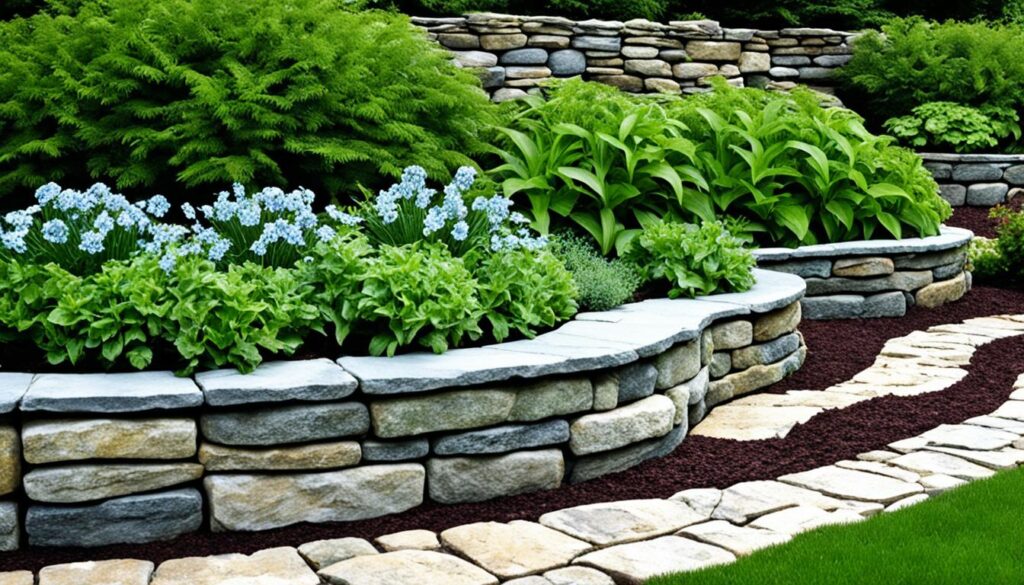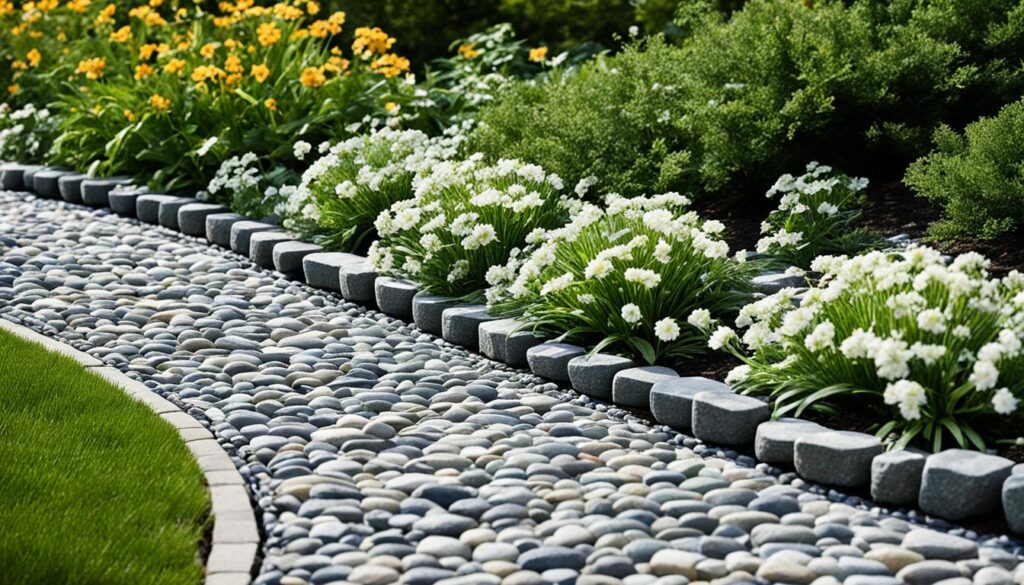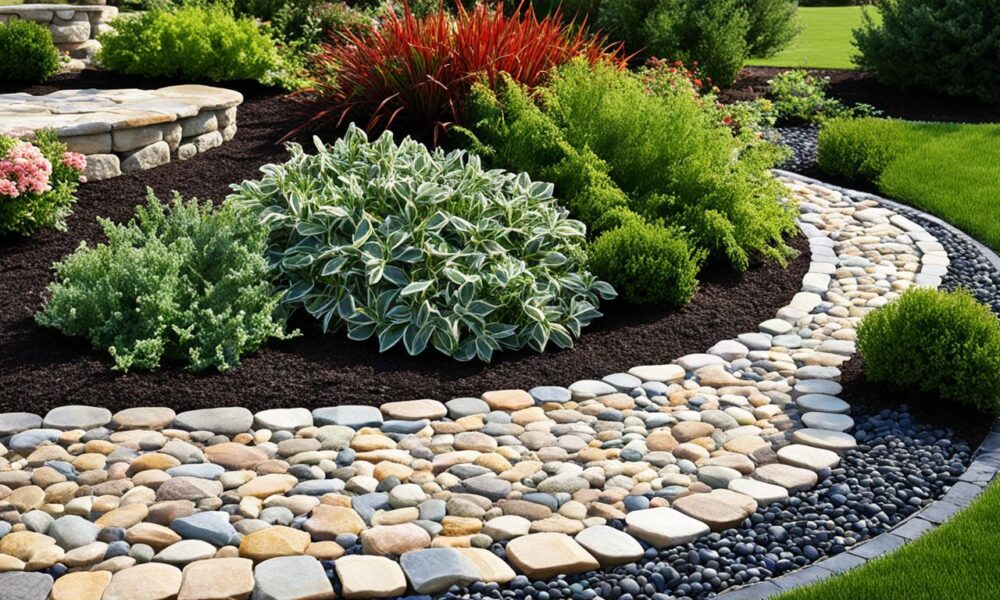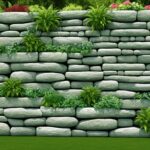Elegant Natural Stone Garden Edging Ideas
Creating a stone garden border edging is a great way to add both visual interest and functionality to your outdoor space. Stone Center offers high-quality natural stones for landscaping edging projects. Stone garden borders have various benefits, including adding structure and definition to your garden beds, protecting your plants, enhancing the overall look of your garden, maintaining soil fertility, preventing erosion, acting as a barrier against pests, and being easy to install and maintain. There are different types of natural stone landscape edging ideas, including natural boulder stone, decorative chipping edging, caged rocks (gabion walls), and pebble edging.
Key Takeaways:
- Natural stone garden edging adds both visual interest and functionality to outdoor spaces.
- Stone garden borders provide structure, protection, and enhancement to garden beds.
- There are different types of natural stone landscape edging ideas to choose from.
- Natural boulder stone, decorative chipping edging, caged rocks, and pebble edging are popular options.
- Natural stone garden edging is easy to install and maintain, offering long-lasting beauty and durability.
Tools and Equipment for Stone Landscape Edging
Creating a stone landscape edging requires specific tools and equipment. Having the right tools is crucial for a successful and efficient stone landscape edging installation.
Here are some essential tools for stone landscape edging:
- Shovel: Used for digging the trench and preparing the ground.
- Wheelbarrow: Aids in transporting materials such as stones, soil, and gravel.
- Level: Ensures the stones are installed evenly and in a straight line.
- Tamper: Helps compact the soil to provide a stable base for the stones.
- Chisel: Utilized for shaping and cutting stones to fit the desired layout.
- Safety gear: Includes gloves, goggles, and a dust mask to protect against injuries and dust.
- Stone cutting saw: Enables precise cuts on larger stones or to create intricate designs.
- Mason’s hammer: Assists in breaking larger stones into smaller pieces.
With these tools, you can efficiently dig the trench, transport materials, ensure even installation, compact the soil, shape and cut stones, and maintain safety throughout the stone landscape edging project.
Having the right tools is crucial for a successful and efficient stone landscape edging installation.
Calculating the Amount of Stone Needed for Edging
In order to ensure you have enough stones for your landscape edging project and minimize waste, it’s important to calculate the amount of stone needed accurately. By following a few simple steps, you can determine the right quantity of stones required for your desired stone edging.
Step 1: Measure the Area
Start by measuring the length and width of the area that you plan to edge with stones. Use a measuring tape or a measuring wheel to get precise measurements. Write down the measurements in feet or inches, depending on your preference.
Step 2: Determine the Thickness
Decide on the desired thickness of the stones for your landscape edging. This will depend on the style and aesthetic you are aiming for, as well as the level of stability and durability required. Measure the thickness in inches and make a note of it.
Step 3: Choose the Edging Style
Consider whether you want a single row or double row stone edging for your project. This will affect the overall amount of stones needed. Keep in mind that a double row edging will require more stones compared to a single row.
Step 4: Account for Waste
It’s always a good idea to add an additional 10% to your total stone calculation to account for waste or errors during installation. This ensures that you have enough stones to complete the project without having to make additional purchases.
Step 5: Consult with your Supplier
Once you have all the necessary measurements and factors considered, consult with your stone supplier to determine the exact amount of stone needed for your edging project. They will be able to provide you with accurate calculations based on the type and size of stones you choose.
By following these steps and accurately calculating the amount of stone needed for your edging, you can ensure a successful and efficient installation, creating a beautiful and functional landscape design.
Natural Stone Landscape Edging Ideas
Enhance the beauty of your outdoor space with these natural stone landscape border ideas. Natural stone offers a variety of options for landscape edging, allowing you to create a stunning and functional garden design.
Natural Boulder Stone
One popular choice for landscape edging is natural boulder stone. With its durability, versatility, and natural beauty, it can effortlessly elevate the look of your garden. Available in different sizes and shapes, natural boulder stone provides endless possibilities for creative design.
Decorative Chipping Edging
Add a touch of customization to your landscape with decorative chipping edging. This easy-to-install option comes in various colors and textures, allowing you to create a unique and personalized garden border. Whether you prefer a bold or subtle look, decorative chipping edging can complement your outdoor aesthetic.
| Benefits of Natural Stone Landscape Edging Ideas |
|---|
| Enhances the beauty of your outdoor space |
| Provides durability and longevity |
| Offers versatility and customization options |
| Acts as a natural barrier against pests |
| Helps regulate soil temperature |
Caged Rocks (Gabion Walls)
If you’re looking for flexibility, strength, and visual appeal, consider using caged rocks, also known as gabion walls. These structures provide a firm base for your garden edging and can be filled with a variety of stones, creating a unique and eye-catching design. Caged rocks offer both functionality and aesthetics to your landscape.
Pebble Edging
An affordable and practical option for garden edging is pebble edging. These small stones not only add visual interest but also help regulate soil temperature. Pebble edging is a cost-effective way to enhance the appearance of your outdoor space while providing added benefits to your plants.
With these natural stone landscape edging ideas, you can transform your outdoor space into a visually appealing and enduring oasis. Explore the possibilities that natural stone offers and create a garden design that reflects your personal style and enhances the overall beauty of your landscape.
Step-by-Step Guide for Creating a Garden Border
Creating a garden border with natural stone involves several steps. Follow this step-by-step guide to design a beautiful and functional garden border using stone garden border designs and ensure a successful garden border installation.
Evaluate Soil Type and Choose Plants
Start by evaluating your soil type to determine its drainage and nutrient levels. This will help you select the right plants for your garden border. Consider the location and design of your garden when choosing plants that thrive in your specific conditions.
Mark Out the Border Area
Use a garden hose or stakes and string to mark out the area where you want to add the border. This will help you visualize the shape and size of your garden border. Take your time to get the measurements and layout just right.
Dig a Trench and Install Weed Membrane
With the border area marked out, dig a trench along the perimeter of your garden border. The depth of the trench will depend on the thickness of the stone edging you plan to use. Install a weed membrane along the bottom of the trench to prevent the growth of unwanted plants and weeds.
Place and Level the Stone Edging
Place the stone edging into the trench, ensuring it fits snugly and is level. Use a level to check for evenness and make adjustments as needed. This will ensure a professional-looking garden border that adds structure and definition to your outdoor space.
Backfill Gaps and Add Additional Features
Backfill the gaps between the stones with soil or gravel to secure the edging in place. This will provide stability and prevent shifting over time. Additionally, consider adding lawn edging for raised-bed borders or other features to enhance the look and functionality of your garden border.
Follow these steps to create a stunning garden border that complements your landscape and adds a touch of elegance to your outdoor space.

Brick Garden Edging
Brick garden edging is a classic and affordable option that adds a touch of elegance to any outdoor space. By using bricks as a border, you can create a defined and structured look for your garden. The versatility of bricks allows you to arrange them tightly together, preventing turf from slipping through and maintaining a clean and tidy appearance.
One of the advantages of brick garden edging is its functionality as a mowing strip. By setting the bricks just above the soil level, you eliminate the need for trimming, making lawn maintenance a breeze. Additionally, the diagonal placement of mismatched bricks can create a unique domino effect, adding visual interest to your garden design.
Brick edging provides a rustic and timeless look that complements various garden styles. Whether you have a traditional, contemporary, or cottage-style garden, brick edging adds a charming touch. The natural earthy tones of bricks blend seamlessly with the surrounding vegetation, enhancing the overall aesthetic appeal.
To ensure a stable and even installation, it is recommended to install brick garden edging in a bed of sand. This helps prevent heaving and unevenness over time, ensuring that your garden border remains intact and visually pleasing.
With brick garden edging, you can create a beautiful and functional border for your garden. Its affordability, versatility, and durability make it a popular choice among homeowners and landscaping enthusiasts. Whether you prefer a rustic, traditional, or contemporary look, brick garden edging offers endless design possibilities for enhancing the beauty of your outdoor space.
Flagstone Garden Edging
Flagstone garden edging offers a versatile and charming option for enhancing your outdoor space, especially if you have a country or cottage garden. With various colors and thicknesses to choose from, flagstones allow you to coordinate or contrast with your plants and other stone elements, creating a visually stunning landscape.
Flagstone garden edging is durable and stacks securely, ensuring a long-lasting and timeless look for your yard. The natural beauty of flagstones adds a classic touch to your garden, seamlessly blending with the surrounding environment.
One of the unique features of flagstone garden edging is its versatility. By laying flagstones in a winding pattern, you can create a distinctive border design that adds character and charm to your outdoor space. Whether you prefer a rustic or refined look, flagstone edging can be adapted to suit your personal style and preferences.
Benefits of Flagstone Garden Edging
Flagstone garden edging offers several advantages for your landscape:
- Enhances the visual appeal of your garden with its natural and elegant look.
- Provides a durable and secure border, ensuring longevity and stability in your yard.
- Allows for coordination or contrast with plants and other stone elements, giving you creative design options.
- Creates a seamless transition between your garden and other outdoor areas, adding aesthetic continuity.
- Offers versatility in terms of colors, thicknesses, and patterns, allowing you to personalize your garden edging.
Installation Tips for Flagstone Garden Edging
When installing flagstone garden edging, consider the following tips:
- Plan your design and desired pattern before starting the installation process.
- Prepare the ground by leveling it and removing any debris or vegetation.
- Place a layer of sand or gravel as a base to provide stability to the flagstones.
- Lay the flagstones in your chosen pattern, ensuring they fit snugly together.
- Use a level to check that the stones are even and adjust as needed.
- Fill the gaps between the stones with sand or gravel, allowing for proper drainage.
- Compact the stones and backfill materials for a secure and stable edging.
- Regularly maintain and clean the flagstone edging to keep it looking its best.
Rock Garden Edging
Mixing and matching rocks of different shapes and colors can create a natural and artistic stone garden edging. Large multicolor rocks can be positioned in a winding pattern, allowing plants to creep over and between the rocks and creating a lacy, scalloped look. Rock garden edging adds texture, color, and visual interest to the landscape, providing a unique and eye-catching design.
Benefits of Rock Garden Edging
- Adds a natural and artistic touch to your garden
- Creates a unique and eye-catching design
- Allows plants to grow and creep over and between the rocks
- Provides texture and color to the landscape
- Durable and long-lasting
- Low maintenance
Choosing Rocks for Garden Edging
When selecting rocks for your garden edging, consider the size, shape, and color that best complements your overall garden design. Opt for rocks that are large enough to make a statement but not too heavy to handle. Look for rocks with interesting textures and colors to add visual interest to your garden. Consider using a variety of rocks to create a dynamic and layered effect.
Installation Tips
To ensure a successful rock garden edging installation, follow these tips:
- Prepare the ground by removing any grass or vegetation and leveling the area.
- Create a border or trench where you want to place the rocks.
- Place a layer of landscape fabric or weed barrier to prevent weed growth.
- Start placing the rocks, ensuring they are stable and level.
- Fill in the gaps between the rocks with soil or gravel.
- Water the area thoroughly to settle the rocks and soil.
Maintenance
Rock garden edging requires minimal maintenance. Remove any weeds or debris that may accumulate between the rocks. Periodically check for any loose or unstable rocks and reposition them if necessary. Additionally, consider adding a layer of mulch around the rocks to help suppress weed growth and retain moisture.
Granite Cobbles Garden Edging
Square cobbles made of granite can provide a structured and defined look to your garden edging. The natural beauty and durability of granite make it an excellent choice for creating a stylish and long-lasting border.
“Granite cobbles add an elegant touch to any garden,” says landscape designer Jane Adams. “Their clean lines and rich texture create a sense of sophistication while defining the boundaries of your outdoor space.”
When designing your granite cobbles garden edging, consider incorporating a hedge of Korean boxwood for added shape and contrast. The combination of the smooth granite cobbles and the lush greenery creates an appealing visual aesthetic that will elevate the overall look of your landscape.
Achieving Balance
To soften the hard edges of the granite cobbles and add a splash of color, consider planting low-growing plants along the edge of the border. Flowers like creeping thyme, alyssum, or sedum can cascade over the cobbles, creating a beautiful contrast between the vibrant blooms and the cool tones of the granite.
“The key to successful granite cobbles garden edging is achieving a balance between structure and softness,” advises landscape architect David Thompson. “By integrating foliage and blooms that spill over the edges, you create a harmonious blend of hard and soft elements.”
| Advantages of Granite Cobbles Garden Edging |
|---|
| 1. Durability: Granite is a natural stone known for its strength and resilience, making it suitable for long-term garden borders. |
| 2. Low Maintenance: Once installed, granite cobbles require minimal upkeep, allowing you to enjoy your garden without constant maintenance. |
| 3. Versatility: Granite cobbles come in various sizes and colors, allowing you to create a customized garden border that complements your landscaping. |
| 4. Visual Appeal: The clean lines and natural texture of granite cobbles add an elegant touch to your garden, enhancing its overall aesthetic. |
By incorporating granite cobbles into your garden edging design, you can achieve a structured and visually appealing outdoor space that will impress visitors and provide a lasting sense of beauty.

Boulders as Garden Edging
Boulders can offer a bold and dramatic statement as garden edging. They can be used as individual focal points or as a continuous edging line. Boulders create a striking contrast with plants and greenery, instantly elevating the overall aesthetic of the outdoor space. They add visual interest and define the boundaries of the landscape.
Boulders are not only functional but also visually appealing. Their natural shapes and textures add depth and character to garden borders. By strategically placing boulders, you can create a sense of structure and showcase the beauty of your plants. Whether used in a modern or rustic garden, boulders can add a touch of drama that transforms your outdoor space into a captivating sanctuary.
Boulders as garden edging provide a simple yet powerful way to make a statement in your landscape. They offer durability and require minimal maintenance, making them a practical choice for any garden design.
Benefits of using boulders for garden edging:
- Creates a natural and organic look.
- Adds visual interest and focal points.
- Defines the boundaries of the garden.
- Provides a sturdy and long-lasting border.
- Requires minimal maintenance.
Tips for using boulders as garden edging:
- Select boulders of different sizes and shapes to create a varied and dynamic border.
- Consider the scale of your garden and choose boulders that complement the overall design.
- Place boulders strategically to create a natural flow and guide the eye.
- Ensure the boulders are securely positioned to prevent shifting or movement.
- Use landscaping fabric or gravel as a base to stabilize the boulders and prevent weed growth.
With their impressive presence and ability to transform any garden, boulders make an excellent choice for creating a dramatic stone garden border. Whether you want to enhance the elegance of a formal garden or add a touch of ruggedness to a natural landscape, boulders as garden edging are sure to make a statement.
Conclusion
Natural stone garden edging ideas offer an excellent way to enhance the beauty and functionality of your outdoor space. Whether you opt for DIY garden edging with natural stones such as boulder stone, decorative chipping edging, caged rocks (gabion walls), or pebble edging, each option has its unique benefits. By following a step-by-step guide for creating a garden border, you can achieve stunning results that will transform your outdoor space into a visually appealing and enduring oasis.
When choosing the best rocks for garden edging, consider your desired style, budget, and preferences. Brick, flagstone, rock, granite cobbles, and boulders are all excellent choices that can add a touch of elegance and structure to your landscape. The versatility and natural beauty of these stones make them ideal for creating captivating garden borders.
With the right natural stone garden edging ideas and materials at your disposal, you can create a harmonious and inviting outdoor space that reflects your personal taste and style. Whether you’re seeking a rustic, country, or contemporary look for your garden, these options provide endless possibilities. So grab your tools, get creative, and embark on a DIY garden edging project with natural stones to transform your outdoor haven into a stunning masterpiece.



